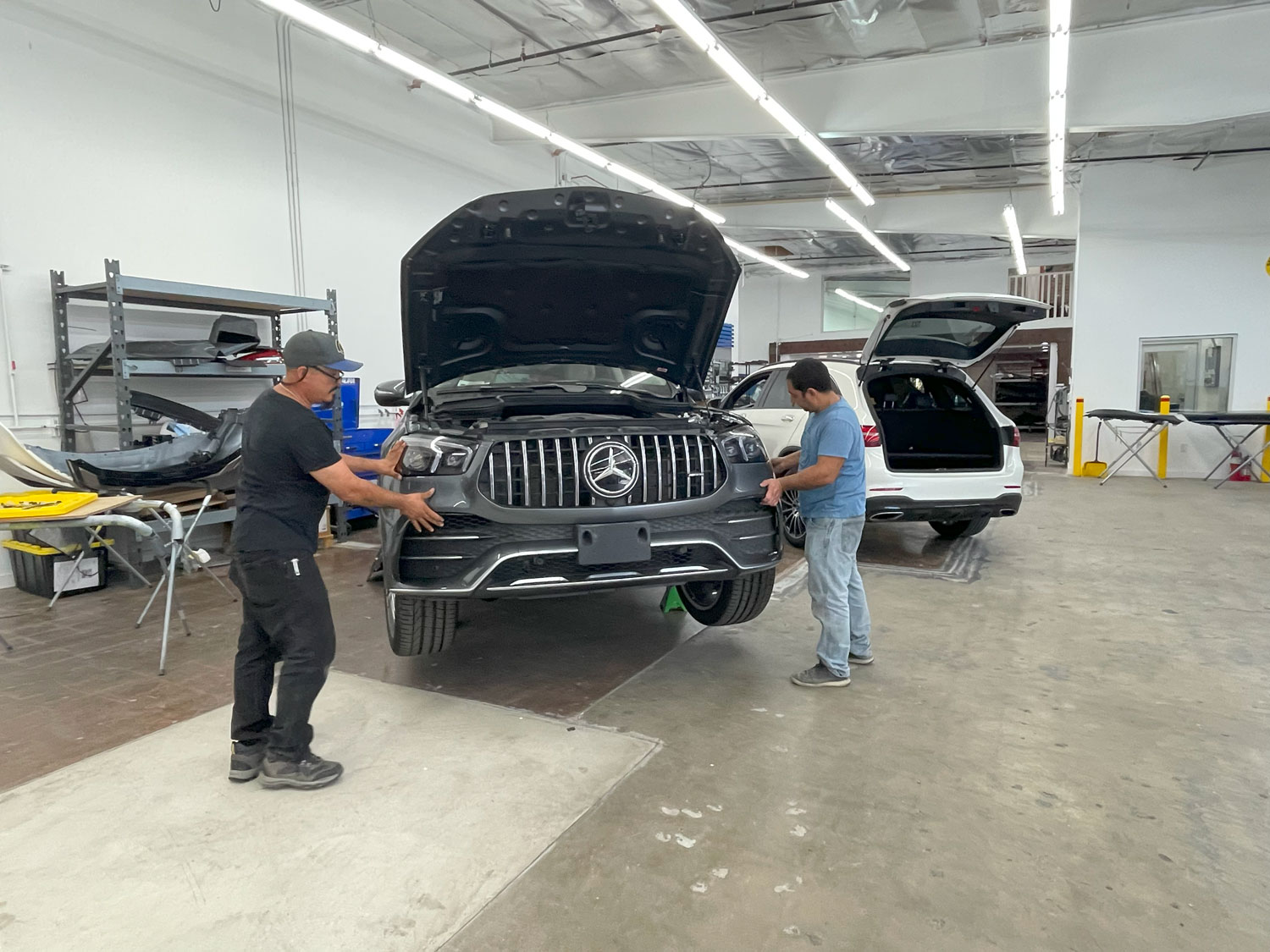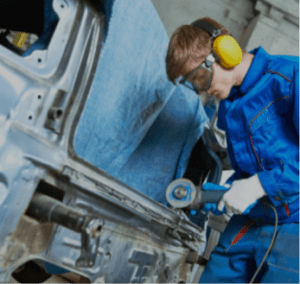Experiencing a gap between the insurance estimate and the body shop’s estimate can be a frustrating ordeal for vehicle owners. When the insurance estimate falls short of the repair costs quoted by the body shop, it leaves many wondering, how do body shops work with car insurance?
We put together this guide to explain how auto body repair estimates work, look at the reasons behind differences between insurance and body shop estimates, and provide steps you can take to tackle this situation.
Table of Contents:
- How Auto Body Repair Estimates Work
- Why there Might Be a Gap Between the Insurance Estimate and Body Shop Estimate
- What You Can Do If the Insurance Check Is Less Than Repairs
- Frequently Asked Questions: Insurance Estimate Lower Than Body Shop
- Contact Network Auto Body for Your Accident Repair Estimates
How Auto Body Repair Estimates Work
When your vehicle is damaged in an accident, the first step is to get an estimate for repairs. This estimate serves as a preliminary assessment of the anticipated repair costs based on the visible damage. However, it’s important to understand that the actual repair costs may differ from the initial estimate, depending on factors such as hidden damage and labor rates.
Estimate Differences: Original Estimate vs Final Repair Bill
The original estimate provided by the insurance company or the body shop serves as a starting point for the repair process. It outlines the anticipated repair costs, parts needed, and labor charges. However, as the repair progresses, additional damage may be discovered, or unforeseen complications may arise, leading to adjustments in the final repair bill.
Supplements
Your body shop will send these new repair needs to your insurance company as supplements. These supplements account for unforeseen damage or necessary repairs discovered during the repair process, such as hidden damage or parts requiring replacement. By providing supplements, the auto body shop ensures that all necessary repairs are addressed and documented, allowing for a comprehensive and accurate assessment of the repair costs.
Once all work is completed, the final bill will often be larger than the original estimate. Now, let’s look at why an auto body repair shop and insurance company might have different estimates.
Why there Might Be a Gap Between the Insurance Estimate and Body Shop Estimate
Several factors can contribute to a gap between the insurance estimate and the body shop’s estimate:
- Hidden Damage: Damage that is not initially visible may only be uncovered during the repair process, necessitating additional repairs and costs. The first insurance estimate will be done visually before the car is broken down.
- Labor Rates: Body shops may have different labor rates than those estimated by the insurance company, leading to discrepancies in repair costs.
- Parts Prices: Variations in the cost of parts, including OEM (Original Equipment Manufacturer) versus aftermarket parts, can impact the overall repair estimate.
- Quality of Repairs: Body shops may prioritize quality repairs and use premium materials, which can result in higher costs compared to the insurance estimate.
What You Can Do If the Insurance Check Is Less Than Repairs
1. Let the Insurance Company and Repair Shop Negotiate
If there’s a discrepancy between the insurance estimate and the body shop’s estimate, you can allow the insurance company and the repair shop to negotiate directly. The repair shop can provide documentation and justification for the additional repair costs, while the insurance company may reconsider its initial estimate.
2. Let the Insurance Company and Dealership Negotiate
In some cases, the repair shop may need to source parts from the dealership, leading to higher costs. Allowing the insurance company and the dealership to negotiate directly can help bridge the gap between the estimates and ensure the necessary repairs are completed using genuine parts.
3. Accept the Insurance Company’s Offer
If the difference between the insurance estimate and the body shop’s estimate is relatively minor, you may choose to accept the insurance company’s offer and cover the remaining costs out of pocket. However, ensure that the repairs meet your standards and comply with safety regulations.
4. Begin Arbitration with Your Insurance Company
If negotiations with the insurance company fail to yield a satisfactory resolution, you can escalate the matter by initiating arbitration. This involves a neutral third party reviewing the evidence presented by both parties and making a binding decision on the dispute. Some policies have an arbitration provision written into them, so be sure to check the details of your policy.
Frequently Asked Questions: Insurance Estimate Lower Than Body Shop
Q: Why is there a difference between the insurance estimate and the body shop’s estimate?
The disparity can stem from factors like hidden damage not seen during the initial appraisal, variations in labor rates, differences in parts prices, or the body shop’s commitment to quality repairs.
Q: What should I do if the insurance estimate is lower than the body shop‘s estimate?
You can negotiate with the insurance company, provide documentation to support additional costs, or consider covering the difference out of pocket.
Q: Will the insurance company cover additional costs if the repair exceeds their estimate?
In some cases, the insurance company may cover additional costs if they’re justified and documented by the body shop.
Q: Can I use a different body shop if the insurance estimate is lower?
Yes, you have the right to choose a body shop that meets your needs and preferences, regardless of the insurance company’s estimate.
Q: How can I ensure that the repairs are completed properly if the insurance estimate is lower?
You can communicate with the body shop to ensure they prioritize quality repairs and use genuine parts, even if the insurance estimate falls short.
Q: What if the body shop discovers additional damage after starting the repairs?
The body shop can submit supplements to the insurance company to account for any additional damage or necessary repairs uncovered during the process.
Q: Will using aftermarket parts instead of OEM parts lower the repair costs?
While aftermarket parts may be cheaper, they may not offer the same quality or fit as OEM parts, potentially affecting the repair’s longevity and resale value.
Q: How long does it typically take to resolve discrepancies between estimates?
The resolution timeline can vary depending on the complexity of the discrepancies and the willingness of the parties involved to negotiate.
Q: Can I dispute the insurance company’s estimate if I believe it’s too low?
Yes, you can dispute the estimate by providing evidence and documentation to support the additional costs required for proper repairs.
Q: What if the insurance company refuses to cover the full cost of repairs?
If negotiations fail to yield a satisfactory resolution, you may consider seeking arbitration or legal assistance to address the discrepancy between estimates.
Contact Network Auto Body for Your Accident Repair Estimates
Coming across a gap between the insurance estimate and the body shop’s estimate is not uncommon when it comes to auto body repairs. By understanding the factors contributing to these differences and exploring potential solutions, you can effectively tackle the challenge and ensure that your vehicle receives the necessary repairs without compromising on quality or safety.
Whether through negotiation, accepting partial coverage, or seeking arbitration, you should make sure to advocate for fair and reasonable treatment from both the insurance company and the repair shop.
If you’ve been in an accident and need an auto body shop insurance quote, contact Network Auto Body at your nearest location: North Hollywood, Van Nuys, Valencia, Beverly Blvd., and Downtown LA.




